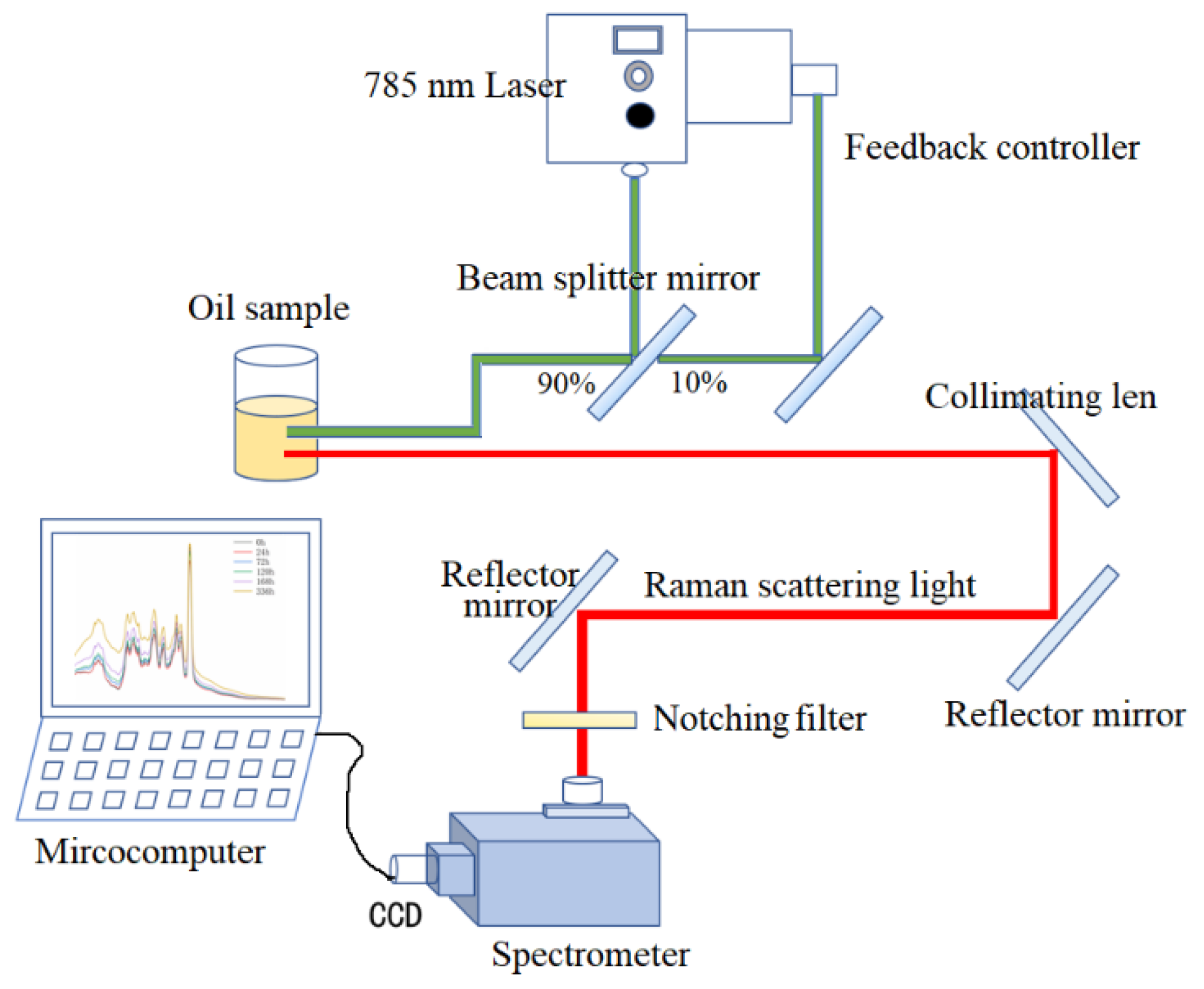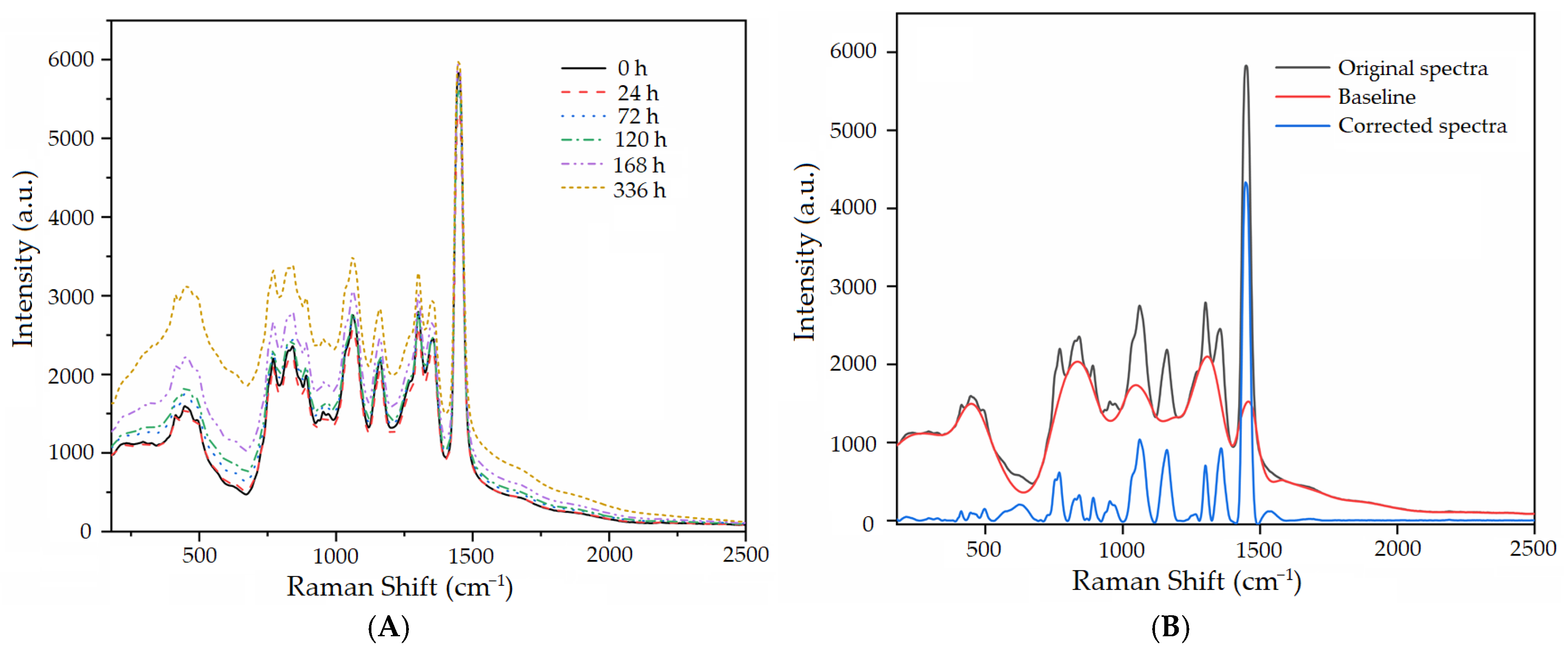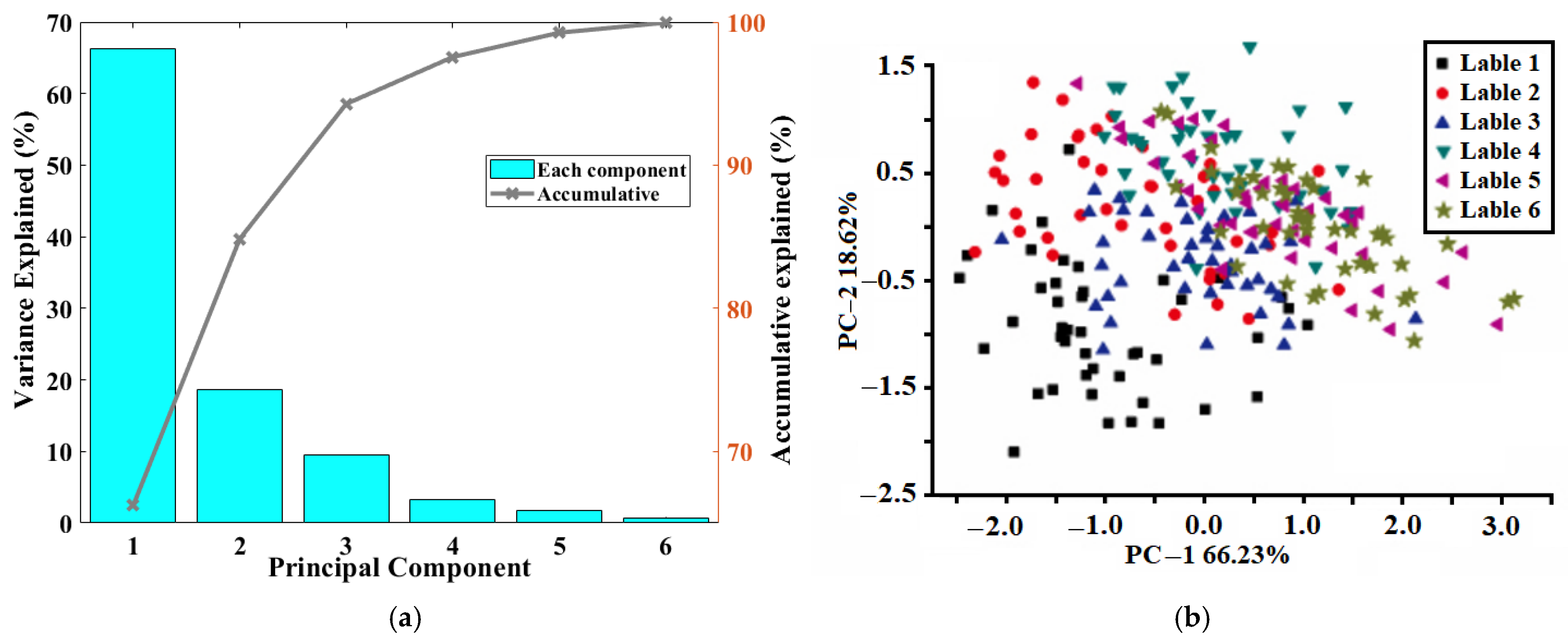Assessment of the Aging State for Transformer Oil-Barrier Insulation by Raman Spectroscopy and Optimized Support Vector Machine
Abstract
:1. Introduction
2. Materials and Methods
2.1. Samples Preparation of Oil-Barrier Insulation Aging Specimens
2.2. Raman Spectroscopy Detection Device
2.3. Spectral Classification Algorithm
2.3.1. Savitzky–Golay Smooth
2.3.2. Asymmetric Reweighted Penalized Least Squares
2.3.3. Principal Component Analysis
2.3.4. Support Vector Machine
3. Results and Discussion
3.1. Analysis of Spectral Profile
3.2. Division of Samples
3.3. Dimension Reduction by Threshold and PCA
3.4. Classification by SVM on the Reduced Spectra
3.5. Classification by PCA-SVM
4. Conclusions
Author Contributions
Funding
Institutional Review Board Statement
Informed Consent Statement
Data Availability Statement
Conflicts of Interest
References
- Kaliappan, G.; Rengaraj, M. Aging assessment of transformer solid insulation: A review. Mater. Today Proc. 2021, 47, 272–277. [Google Scholar] [CrossRef]
- Antony Raj, R. Space charge and its effects on oil-paper insulation in power transformers: A review. J. Electrost. 2023, 126, 103861. [Google Scholar] [CrossRef]
- Shen, Z.; Wang, F.; Wang, Z.; Li, J. A critical review of plant-based insulating fluids for transformer: 30-year development. Renew. Sustain. Energy Rev. 2021, 141, 110783. [Google Scholar] [CrossRef]
- Brncal, P.; Gutten, M. Analysis of insulation properties of transformer materials at different ambient temperatures. Transp. Res. Procedia 2019, 40, 12–15. [Google Scholar] [CrossRef]
- Zhang, M.; Lei, S.; Liu, J.; Wang, S.; Liu, H.; Shi, Y.; Jia, H.; Li, L. Nonlinear characteristics of the oil-paper insulation system during the polarization and depolarization process. Measurement 2023, 214, 112740. [Google Scholar] [CrossRef]
- Vrsaljko, D.; Haramija, V.; Hadži-Skerlev, A. Determination of phenol, m-cresol and o-cresol in transformer oil by HPLC method. Electr. Power Syst. Res. 2012, 93, 24–31. [Google Scholar] [CrossRef]
- Simões, A.N.; Lustosa, G.M.M.M.; de Souza Morita, E.; de Souza, A.N.; Torres, F.; Bizzo, W.A.; Mazon, T. Room-temperature SnO2-based sensor with Pd-nanoparticles for real-time detection of CO dissolved gas in transformer oil. Mater. Chem. Phys. 2024, 311, 128576. [Google Scholar] [CrossRef]
- Magnotti, G.; Kc, U.; Varghese, P.L.; Barlow, R.S. Raman spectra of methane, ethylene, ethane, dimethyl ether, formaldehyde and propane for combustion applications. J. Quant. Spectrosc. Radiat. Transf. 2015, 163, 80–101. [Google Scholar] [CrossRef]
- Zhang, M.; Lei, S.; Liu, H.; Shen, Y.; Liu, J.; Shi, Y.; Jia, H.; Li, L. Research on nonlinear characteristics for frequency domain dielectric response of transformer oil-paper insulation. Measurement 2022, 204, 112103. [Google Scholar] [CrossRef]
- Abbasi, A.R. Fault detection and diagnosis in power transformers: A comprehensive review and classification of publications and methods. Electr. Power Syst. Res. 2022, 209, 107990. [Google Scholar] [CrossRef]
- Wang, Y.; Xiao, K.; Chen, B.; Li, Y. Study of the Impact of Initial Moisture Content in Oil Impregnated Insulation Paper on Thermal Aging Rate of Condenser Bushing. Energies 2015, 8, 14298–14310. [Google Scholar] [CrossRef]
- Liu, Y.; Ren, X.; Yu, H.; Cheng, Y.; Guo, Y.; Yao, W.; Xie, Y. Non-destructive and online egg freshness assessment from the egg shell based on Raman spectroscopy. Food Control 2020, 118, 107426. [Google Scholar] [CrossRef]
- Wang, H.-P.; Chen, P.; Dai, J.-W.; Liu, D.; Li, J.-Y.; Xu, Y.-P.; Chu, X.-L. Recent advances of chemometric calibration methods in modern spectroscopy: Algorithms, strategy, and related issues. TrAC Trends Anal. Chem. 2022, 153, 116648. [Google Scholar] [CrossRef]
- Estefany, C.; Sun, Z.; Hong, Z.; Du, J. Raman spectroscopy for profiling physical and chemical properties of atmospheric aerosol particles: A review. Ecotoxicol. Environ. Saf. 2023, 249, 114405. [Google Scholar] [CrossRef]
- Sun, Y.; Tang, H.; Zou, X.; Meng, G.; Wu, N. Raman spectroscopy for food quality assurance and safety monitoring: A review. Curr. Opin. Food Sci. 2022, 47, 100910. [Google Scholar] [CrossRef]
- Evangeline, W.P.; Saranya, E.; Rajalakshmi, E.; Murugan, M.; Mahalakshmi, S.; Ramya, V.; Vishwakarma, A.; Ramya, M. Advancements of Raman spectroscopy in cosmetics and dermatology. S. Afr. J. Bot. 2024, 167, 122–129. [Google Scholar] [CrossRef]
- Song, R.; Chen, W.; Zhang, J.; Wang, Z.; Shi, H. Simultaneous detection of multiple aging characteristic components in oil-paper insulation using sensitive Raman technology and microfluidics. Spectrochim. Acta Part A Mol. Biomol. Spectrosc. 2024, 318, 124333. [Google Scholar] [CrossRef]
- Lu, B.; Wu, S.; Liu, D.; Wu, W.; Zhou, W.; Yuan, L.-M. Unsupervised Clustering-Assisted Method for Consensual Quantitative Analysis of Methanol–Gasoline Blends by Raman Spectroscopy. Molecules 2024, 29, 1427. [Google Scholar] [CrossRef]
- Zheng, K.-Y.; Zhang, X.; Tong, P.-J.; Yao, Y.; Du, Y.-P. Pretreating near infrared spectra with fractional order Savitzky–Golay differentiation (FOSGD). Chin. Chem. Lett. 2015, 26, 293–296. [Google Scholar] [CrossRef]
- Kitamura, K.; Hozumi, K. Effect of Savitzky–Golay smoothing on second-derivative spectra. Anal. Chim. Acta 1987, 201, 301–304. [Google Scholar] [CrossRef]
- Pu, Y.; Wang, H.; Lou, C.; Yao, B. An automatic spectral baseline estimation method and its application in industrial alkali-pulverized coal flames. Measurement 2023, 214, 112804. [Google Scholar] [CrossRef]
- Li, H.; Dai, J.; Pan, T.; Chang, C.; So, H.C. Sparse Bayesian learning approach for baseline correction. Chemom. Intell. Lab. 2020, 204, 104088. [Google Scholar] [CrossRef]
- Górski, Ł.; Jakubowska, M. A graphical user interface for arPLS baseline correction. Chemom. Intell. Lab. 2023, 238, 104848. [Google Scholar] [CrossRef]
- Baek, S.-J.; Park, A.; Ahn, Y.-J.; Choo, J. Baseline correction using asymmetrically reweighted penalized least squares smoothing. Analyst 2015, 140, 250–257. [Google Scholar] [CrossRef] [PubMed]
- Chen, X.; Xu, M.; Yuan, L.-M.; Huang, G.; Chen, X.; Shi, W. Degradation degree analysis of environmental microplastics by micro FT-IR imaging technology. Chemosphere 2021, 274, 129779. [Google Scholar] [CrossRef]
- Ding, L.; Yuan, L.-m.; Sun, Y.; Zhang, X.; Li, J.; Yan, Z. Rapid Assessment of Exercise State through Athlete’s Urine Using Temperature-Dependent NIRS Technology. J. Anal. Methods Chem. 2020, 2020, 8828213. [Google Scholar] [CrossRef]
- Cai, J.-r.; Yuan, L.-m.; Liu, B.; Sun, L. Nondestructive gender identification of silkworm cocoons using X-ray imaging with multivariate data analysis. Anal. Methods 2014, 6, 7224–7233. [Google Scholar] [CrossRef]
- Drucker, H.; Wu, D.; Vapnik, V.N. Support vector machines for spam categorization. IEEE Trans. Neural Netw. 1999, 10, 1048–1054. [Google Scholar] [CrossRef]
- Vapnik, V.; Chapelle, O. Bounds on error expectation for support vector machines. Neural. Comput. 2000, 12, 2013–2036. [Google Scholar] [CrossRef]
- Chih-Chung Chang and Chih-Jen Lin, LIBSVM: A library for support vector machines. ACM Trans. Intell. Syst. Technol. 2011, 2, 27. Available online: http://www.csie.ntu.edu.tw/~cjlin/libsvm (accessed on 14 April 2021).
- Yuan, L.-M.; Chen, X.; Lai, Y.; Chen, X.; Shi, Y.; Zhu, D.; Li, L. A Novel Strategy of Clustering Informative Variables for Quantitative Analysis of Potential Toxics Element in Tegillarca Granosa Using Laser-Induced Breakdown Spectroscopy. Food Anal. Methods 2018, 11, 1405–1416. [Google Scholar] [CrossRef]
- Ye, P.; Ji, G.; Yuan, L.-M.; Li, L.; Chen, X.; Karimidehcheshmeh, F.; Chen, X.; Huang, G. A Sparse Classification Based on a Linear Regression Method for Spectral Recognition. Appl. Sci. 2019, 9, 2053. [Google Scholar] [CrossRef]





| Aging Timespan | 0 h | 24 h | 72 h | 120 h | 168 h | 336 h | Number of Samples |
|---|---|---|---|---|---|---|---|
| Labeled class | 1 | 2 | 3 | 4 | 5 | 6 | 384 |
| Calibration set | 40 | 40 | 40 | 40 | 40 | 40 | 240 |
| Prediction set | 24 | 24 | 24 | 24 | 24 | 24 | 144 |
| Optimization Methods | Runtime | Accuracy of Cross-Validation | Accuracy of Prediction |
|---|---|---|---|
| Grid search (GS) | 937 s | 94.58% | 90.28% |
| Particle swarm optimization (PSO) | 1243 s | 93.75% | 88.19% |
| Genetic algorithm (GA) | 1576 s | 93.75% | 88.19% |
Disclaimer/Publisher’s Note: The statements, opinions and data contained in all publications are solely those of the individual author(s) and contributor(s) and not of MDPI and/or the editor(s). MDPI and/or the editor(s) disclaim responsibility for any injury to people or property resulting from any ideas, methods, instructions or products referred to in the content. |
© 2024 by the authors. Licensee MDPI, Basel, Switzerland. This article is an open access article distributed under the terms and conditions of the Creative Commons Attribution (CC BY) license (https://creativecommons.org/licenses/by/4.0/).
Share and Cite
Liu, D.; Lu, B.; Wu, W.; Zhou, W.; Liu, W.; Sun, Y.; Wu, S.; Shi, G.; Yuan, L. Assessment of the Aging State for Transformer Oil-Barrier Insulation by Raman Spectroscopy and Optimized Support Vector Machine. Sensors 2024, 24, 7485. https://doi.org/10.3390/s24237485
Liu D, Lu B, Wu W, Zhou W, Liu W, Sun Y, Wu S, Shi G, Yuan L. Assessment of the Aging State for Transformer Oil-Barrier Insulation by Raman Spectroscopy and Optimized Support Vector Machine. Sensors. 2024; 24(23):7485. https://doi.org/10.3390/s24237485
Chicago/Turabian StyleLiu, Deliang, Biao Lu, Wenping Wu, Wei Zhou, Wansu Liu, Yiye Sun, Shilong Wu, Guolong Shi, and Leiming Yuan. 2024. "Assessment of the Aging State for Transformer Oil-Barrier Insulation by Raman Spectroscopy and Optimized Support Vector Machine" Sensors 24, no. 23: 7485. https://doi.org/10.3390/s24237485
APA StyleLiu, D., Lu, B., Wu, W., Zhou, W., Liu, W., Sun, Y., Wu, S., Shi, G., & Yuan, L. (2024). Assessment of the Aging State for Transformer Oil-Barrier Insulation by Raman Spectroscopy and Optimized Support Vector Machine. Sensors, 24(23), 7485. https://doi.org/10.3390/s24237485






